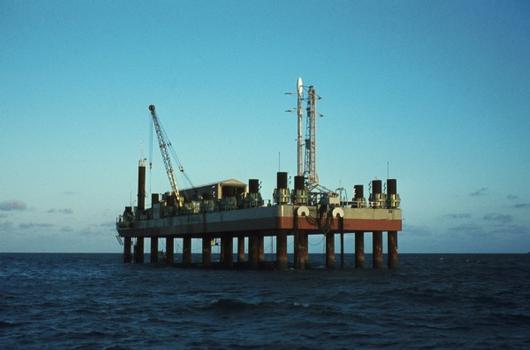General Information
| Other name(s): | Luigi Broglio Space Centre |
|---|---|
| Status: | out of service |
Project Type
| Function / usage: |
original use: Oil or gas platform current use: Spaceport / Launch complex |
|---|
Location
| Location: |
Kenya |
|---|---|
| Coordinates: | 2° 56' 17.02" S 40° 12' 43.92" E |
Technical Information
There currently is no technical data available.
Notes
The platform was built using 2 old oil rigs and used as a spaceport from 1964 until 1988.
Excerpt from Wikipedia
The Luigi Broglio Space Center (BSC) is an Italian-owned spaceport near Malindi, Kenya, named after its founder and Italian space pioneer Luigi Broglio. Developed in the 1960s through a partnership between the Sapienza University of Rome's Aerospace Research Centre and NASA, the BSC served as a spaceport for the launch of both Italian and international satellites (1967–1988). The center comprises a main offshore launch site, known as the San Marco platform, as well as two secondary control platforms and a communications ground station on the mainland.
In 2003 a legislative decree handed the Italian Space Agency management of the center, beginning in 2004, and the name changed from the previous San Marco Equatorial Range. While the ground station is still in use for satellite communications, the BSC is not currently used as a launch site.
History
The San Marco platform was a former oil platform, located to the north of Cape Ras Ngomeni on the coastal sublittoral of Kenya close to the equator (which is an energetically favourable location for rocket launches). Launches from the platform were controlled from the Santa Rita platform, a second former oil platform located southeast of the San Marco platform, and a smaller Santa Rita II housed the facility's radar. A ground station located on the cape forms the center's primary telemetry site.
The Italian space research program began in 1959 with the creation of the CRA (Centro Ricerche Aerospaziali) at the University of Rome. Three years later, on 7 September 1962, the university signed a memorandum of understanding with NASA to collaborate on a space research program named San Marco (St. Mark). The Italian launch team, trained by NASA, was to first launch a rocket from Wallops Island under NASA supervision and first launch successfully took off on 15 December 1964. The San Marco project was focused on the launching of scientific satellites by Scout rockets from a mobile rigid platform located close to the equator. This station, composed of 3 oil platforms and two logistical support boats, was installed off the Kenya coast, close to the town of Malindi.
The program schedule included three phases:
- Suborbital launches from Wallops Island and the equatorial platform,
- Orbital launch of an experimental satellite from Wallops Island,
- Orbital launches from the equatorial platform.
The San Marco launch platform complex was in use from March 1964 to March 1988, with a total of 27 launches, primarily sounding rockets including the Nike Apache, Nike Tomahawk, Arcas and Black Brant launchers. Low payload weight orbital launches were also made, using the solid-propellant Scout rocket (in its B, D and G subvariants). The first satellite specifically for X-ray astronomy, Uhuru, was launched from San Marco on a Scout B rocket on 12 December 1970.
The ground station is in use and continues to track NASA, ESA and Italian satellites. However, the two platforms fell into disrepair during the 1990s. Since then, the Italian Space Agency has conducted a feasibility study to reactivate it for the Russian launcher START-1.
Text imported from Wikipedia article "Broglio Space Center" and modified on June 2, 2020 according to the CC-BY-SA 4.0 International license.
Participants
Currently there is no information available about persons or companies having participated in this project.
Relevant Web Sites
- About this
data sheet - Structure-ID
20035142 - Published on:
08/03/2008 - Last updated on:
20/03/2015





